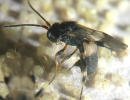 |
Scientific nameChelonus blackburni Cameron
Taxonomic positionHymenoptera: Braconidae: Cheloninae
DiagnosisDorsal side more or less completely black, except antennae dark reddish brown to pitch black; anterior third of metasoma (abdomen) white; fore and mid femoral apices white to pale yellowish brown, hind femora with median third white; all tibiae white; fore tarsi white, remaining pairs
darker towards apices. Fore wing without (Rs+M)a, first submarginal and first discal cells forming a single large confluent cell. Eyes with conspicuous, dense hairs visible at low magnification. Metasoma composed of a single large plate forming a carapace or shield formed by the fusion of the first three metasomal
tergites, convex and sculptured.
ImagesDistributionChelonus blackburni is aparthenogenetic egg-larval parasitoid introduced from Hawaii and now fairly widely established in different parts of India.
HostsEgg-larval parasitoid of several lepidopterous pests like potato tuber moth, Phthorimaea operculella, cotton bollworms, Hellula undalis, Plutella xylostella, etc. It has been used for the biological suppression of P. operculella in Maharashtra, Earias vittella (Fabricius) in Karnataka, E. insulana Stoll. (=E. fabia) in
Maharashtra, Pecinophora gossypiella (Saunders) in Maharashtra and Helicoverpa
armigera (Huebner) on cotton and other host plants in many states. It is becoming an important component of IPM systems on potato, cotton, etc.
Mass productionThis parasitoid is commonly mass produced on the standard laboratory host, Corcyra cephalonica (Stainton) and the potato tuber moth, Phthorimaea operculella (Zeller). It could also be multiplied successfully on Achroia grisella (Fabricius) and Spodoptera exigua (Huebner). Detailed production and release procedures are
outlined in Singh (1994a,b).
Field release The following release dosages are often adopted, depending on the pest.
References
|





